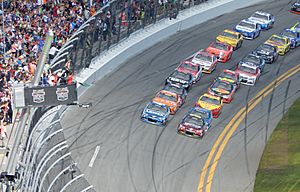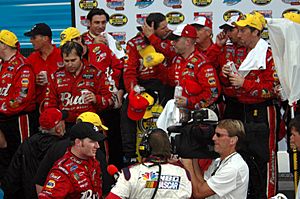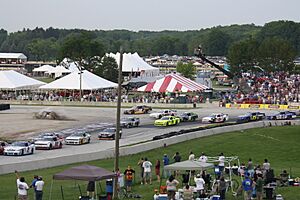NASCAR facts for kids
| Sport | Auto racing |
|---|---|
| Category | Stock car racing Sports car racing (IMSA) |
| Abbreviation | NASCAR |
| Founded | February 21, 1948 |
| Affiliation | ACCUS-FIA |
| Headquarters | Daytona Beach, Florida, U.S. (main) Charlotte, North Carolina, U.S. Concord, North Carolina, U.S. |
| President | Steve Phelps Peter Jung (Vice President, CMO) |
| Chairman | Jim France |
| Chairperson | Mike Helton (Vice Chairman) |
| CEO | Jim France |
| Other key staff |
|
| Official website | |
The National Association for Stock Car Auto Racing, LLC (NASCAR) is an American auto racing sanctioning and operating company that is best known for stock car racing. It is considered to be one of the top ranked motorsports organizations in the world and is one of the largest spectator sports in America. The privately owned company was founded by Bill France Sr. in 1948, and his son, Jim France, has been the CEO since August 2018. The company is headquartered in Daytona Beach, Florida. Each year, NASCAR sanctions over 1,500 races at over 100 tracks in 48 US states, as well as in Canada, Mexico, Brazil and Europe.
The vast majority of NASCAR drivers are American, but drivers from Canada, Mexico, Europe, and other places have competed. All Cup Series races are held across America. There are 36 points-paying races in a season, along with the pre-season Clash and mid-season All-Star race. NASCAR runs races primarily on ovals, including superspeedways, short tracks, and dirt tracks, but also road courses and street circuits.
Richard Petty holds the Cup Series wins record with 200. He is tied with Dale Earnhardt and Jimmie Johnson for the championship record, with seven each. Entering the 2024 season, Ryan Blaney is the defending Cup Series champion.
Contents
History
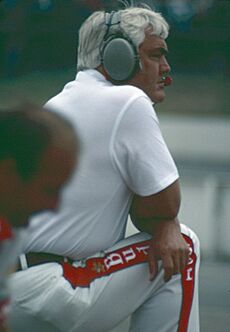
In the 1920s and 1930s, Daytona Beach supplanted France and Belgium as the preferred location for world land speed records. After a historic race between Ransom Olds and Alexander Winton in 1903, 15 records were set on what became the Daytona Beach Road Course between 1905 and 1935. Daytona Beach had become synonymous with fast cars in 1936. Drivers raced on a 4.1-mile (6.6 km) course, consisting of a 1.5–2.0-mile (2.4–3.2 km) stretch of beach as one straightaway, and a narrow blacktop beachfront highway, State Road A1A, as the other. The two straights were connected by two tight, deeply rutted and sand covered turns at each end.
Stock car racing in the United States has its origins in bootlegging during Prohibition, when drivers ran bootleg whiskey made primarily in the Appalachian region of the United States. Bootleggers needed to distribute their illicit products, and they typically used small, fast vehicles to better evade the police. Many of the drivers would modify their cars for speed and handling, as well as increased cargo capacity.
The cars continued to improve, and by the late 1940s, races featuring these cars were being run for pride and profit. These races were popular entertainment in the rural Southern United States, and they are most closely associated with the Wilkes County region of North Carolina. Most races in those days were of modified cars. Street vehicles were lightened and reinforced.
Cup Series
The NASCAR Cup Series (NCS) is the sport's highest level of professional competition. It is consequently the most popular and most profitable NASCAR series. Since 2001, the Cup Series season has consisted of 36 races over 10 months. Writers and fans often use "Cup" to refer to the NCS and the ambiguous use of "NASCAR" as a synonym for the series is common. The 2023 NCS Champion is Ryan Blaney. The record for most championships is 7, held by three drivers: Richard Petty, Dale Earnhardt, and Jimmie Johnson. Johnson has the record for most consecutive with five consecutive Cup Series drivers' championships from 2006 to 2010. Previously, the most consecutive championships had been three in a row by Cale Yarborough in the late 1970s, the only other time when a driver has won three or more NASCAR Cup Series championships in a row.
The Cup Series had its first title sponsor in 1972. R. J. Reynolds Tobacco Company, which had been banned from television advertising, found a popular and demographically suitable consumer base in NASCAR fans and engaged NASCAR as a promotional outlet. As a result of that sponsorship, the Grand National Series became known as the Winston Cup Series starting in 1971, with a new points system and some significant cash benefits to compete for championship points. In 1972, the season was shortened from 48 races (including two on dirt tracks) to 31. 1972 is often acknowledged as the beginning of NASCAR's "modern era". The next competitive level, called Late Model Sportsman, gained the "Grand National" title passed down from the top division and soon found a sponsor in Busch Beer.
In 2004, Nextel Communications took over sponsorship of the premier series, and formally renamed it the Nextel Cup Series. A new championship points system, the "Chase for the Nextel Cup," (renamed "Chase for the Sprint Cup" in 2008) was also developed, which reset the point standings with ten races to go, making only drivers in the top ten or within 400 points of the leader eligible to win the championship. In 2007, NASCAR announced it was expanding "The Chase" from ten to twelve drivers, eliminating the 400-point cutoff, and giving a ten-point bonus to the top twelve drivers for each of the races they have won out of the first 26. Wins throughout the season would also be awarded five more points than in previous seasons. In 2008, the premier series title name became the Sprint Cup Series, as part of the merger between Nextel and Sprint.
In 2011, NASCAR announced a number of major rules changes, the most significant being abandoning the points system. The winner of a race now receives 43 points, with one-point decrements for each subsequent position (42 for second, 41 for third, and so on). The winner also receives 3 bonus points, and single bonus points are awarded to all drivers who lead a lap, plus the driver who leads the most laps. Another significant change involves the qualifying process for the Chase. The number of qualifying drivers will remain at 12, but only the top 10 will qualify solely on regular-season points. The remaining two Chase drivers will be the two drivers in the next 10 of the point standings (11th through 20th) with the most race wins in the regular season.
In 2014, NASCAR announced another revamp to the Chase format, expanding the Chase pool to 16 drivers, and eliminating four drivers after every three races, leaving four drivers to compete for the championship at the season finale at Homestead. In addition, wins were given an increased emphasis, with the 16 drivers with the most wins (15 if the points leader is winless; points leader will receive an automatic berth) gaining a spot in the chase. If there are fewer than 16 winners, the remaining spots will be filled based on the conventional points system.
Monster Energy became the title sponsor in 2017, which changed the series' name to Monster Energy NASCAR Cup Series. With Monster Energy's title sponsorship, NASCAR also abandoned "The Chase" name and now refers to the last 10 races simply as "the playoffs" similar to most other sports.
After the 2019 season, NASCAR declined an offer from Monster Energy to remain the title sponsor of the top series. On December 5, NASCAR revealed their new sponsorship model. Instead of a singular title sponsor, four "premier partners" (Coca-Cola, Xfinity, Busch Beer and GEICO) would be closely affiliated with the top series, which was simply renamed the NASCAR Cup Series.
Xfinity Series
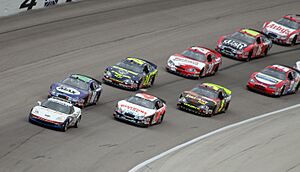
The NASCAR Xfinity Series is the second-highest level of professional competition in NASCAR. The most recent series champion is Cole Custer in 2023. The modern incarnation of this series began in 1982, with sponsorship by Anheuser-Busch Brewing's Budweiser brand. In 1984 it was renamed to the Busch Grand National Series, then later just the Busch Series. The Anheuser-Busch sponsorship expired at the end of 2007, being replaced by Nationwide Insurance from 2008 to 2014, and the series is now sponsored by Comcast through its Xfinity brand.
The season usually has fewer races than the Cup Series, and the prize money is significantly lower. However, over the last several years, a number of Cup Series drivers have run both the Xfinity and Cup Series events each weekend, using the Xfinity race as a warm-up to the Cup event at the same facility. Furthermore, several drivers not only participated in both Cup and Busch/Nationwide/Xfinity events on the same weekend but also began to compete in both series on a full-time basis. Kevin Harvick was the first Cup series driver to compete full-time in the Busch Series and win a title, actually doing so twice; in 2001, he did this for Richard Childress Racing but only did so out of necessity as Dale Earnhardt's death forced him into the Cup series ahead of RCR's intended schedule for him. His win in 2006, where he raced three cars for RCR and his race team, was the first of five consecutive titles in NBS/NNS that were won by Cup series regulars.
The practice received criticism because it was thought to give the Cup Series teams an unfair advantage, and that the presence of the Cup Series drivers squeezes out Nationwide Series competitors who would otherwise be able to qualify. These dual-series drivers have been labeled "Buschwhackers", a play on words which combines the original series sponsor's name with the notion of being bushwhacked. In May 2007, NNS director Joe Balash confirmed that NASCAR was exploring options to deal with the Buschwhacker controversy. One of the most often-cited proposals was for Cup Series drivers participating in the Nationwide Series to receive no points for their participation in a Nationwide race. In 2007, NASCAR chairman Brian France indicated that all options, except an outright ban of Cup competitors, were still being considered. On January 11, 2011, NASCAR.com reported that beginning with the 2011 season, drivers would be allowed to compete for the championship in only one of NASCAR's three national series in a given season, although they could continue to run in multiple series. This change was officially confirmed by France in a press conference less than two weeks later, and has remained in the NASCAR rules ever since.
Beginning in 2010, the Nationwide cars adapted somewhat to the current "Car of Tomorrow" (or COT) design used by Cup cars, with different bodies from the Cup Series.
In 2016, the Chase format was extended to both the Xfinity and Truck Series. Instead of the four-round, 10-race format used in the Cup Series, the Chase in each of the two supporting series consists of three rounds and seven races in all, with each preliminary round consisting of three races. The Xfinity Series Chase involves 12 drivers instead of the 16 participating in the Cup Series Chase. Four drivers are eliminated at the end of each preliminary round of the Chase in the Xfinity Series, which also mirrors the Cup Series Chase. This means that four drivers are eligible for the series title entering the final race, as in the Cup Series. Similar to Cup, starting in 2017 "The Chase" moniker was dropped and the final seven races are now referred to as the Xfinity Playoffs.
Even with restrictions limiting points earnings to one national series, Cup drivers were still running and winning a vast majority of Xfinity series races through 2015. Starting with the 2015 season finale, NASCAR began to add additional restrictions in regards to Cup drivers running Xfinity races. Beginning in the 2020 season, Cup drivers with more than three years of experience in the top series were limited to five races per season. Furthermore, those same drivers are ineligible to run the regular season finale, NXS playoff races, or Dash 4 Cash races.
Craftsman Truck Series
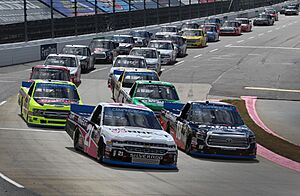
The NASCAR Craftsman Truck Series features modified pickup trucks. It is one of the three national divisions of NASCAR, together with the Xfinity and Cup Series. The most recent series champion is Ben Rhodes in 2023.
In 1994, NASCAR announced the formation of the NASCAR SuperTruck Series presented by Craftsman. The first series race followed in 1995. In 1996, the series was renamed the NASCAR Craftsman Truck Series to emphasize Craftsman's involvement. The series was first considered something of an oddity or a "senior tour" for NASCAR drivers, but eventually grew in popularity and has seen drivers move straight to the Cup Series without running a full season in NASCAR Xfinity Series competition. These include Kurt Busch and Carl Edwards (who both ran for Roush Racing). In addition, veteran drivers who have had only moderate success at the other two levels of the sport have revitalized their careers in the truck series, including Ron Hornaday Jr., Todd Bodine, Mike Skinner, and Johnny Benson.
Beginning in 2009, the series became the Camping World Truck Series. In 2019, per a branding request made by Camping World, the series was rebranded as the NASCAR Gander Outdoors Truck Series.
As noted previously, the Chase format was extended to the Truck Series in 2016. The format is identical to that used in the Xfinity Series, except that only eight drivers qualify for the Chase (instead of 12 in the Xfinity Series) and only two drivers are eliminated at the end of each preliminary round (instead of four in the Xfinity Series). As in both the Cup Series and Xfinity Series, four drivers are eligible for the series title entering the final race. Similar to Cup, starting in 2017 "The Chase" moniker was dropped and is now simply referred to as the Truck Series Playoffs.
On May 8, 2018, NASCAR and Camping World announced the Truck Series title sponsor would be moved to Camping World subsidiary Gander Outdoors starting in 2019. The contract through 2022 is scheduled to continue as planned. The series was renamed again in 2020 to the NASCAR Gander RV & Outdoors Truck Series before returning to the Camping World Truck Series name in 2021.
On August 26, 2022 it was announced that the original series' sponsor, Craftsman, would return as the title sponsor starting in the 2023 season.
NASCAR in culture
Movies about NASCAR racing include Days of Thunder (1990), Herbie: Fully Loaded (2005), Talladega Nights: The Ballad of Ricky Bobby (2006), Ta Ra Rum Pum (2007), and Logan Lucky (2017).
NASCAR racing heavily influenced Pixar's Cars franchise, with the third film in particular drawing inspiration from NASCAR's history.
NASCAR drivers have made appearances in many television series and TV movies, including The Cleveland Show, Sullivan & Son, and Last Man Standing.
NASCAR partnered up with popular Roblox game Jailbreak, and the partnership was launched on November 5. NASCAR also partnered with the developers of Jailbreak to launch NASCAR Speed Hub to celebrate NASCAR's 75th Anniversary.
Images for kids
-
2008 Dodge Charger "Car of Tomorrow", driven by Kurt Busch
See also
 In Spanish: NASCAR para niños
In Spanish: NASCAR para niños


